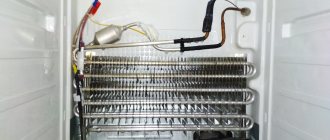Transporting in an incorrect position
The refrigerator is best transported vertically. On the side or back wall - as a last resort. The same applies to lifting and delivery to the floor. If he was brought in lying down, it’s the same as being brought in in that position.
The fact is that the refrigerator compressor is located at the bottom. There is a compressor small in its crankcase. When transported lying down or on its side, it ends up in the freon tubes. From there the oil flows into the evaporator or condenser. Although he shouldn't be there. Regarding transportation methods, we recommend reading the article about the correct transportation of the refrigerator in different positions.
Advice
If you have to transport or carry the refrigerator on its side, read the instructions. Manufacturers indicate on which side it should be transported - left or right.
Improperly carrying the refrigerator.
Shaking during transportation
A lot of shaking during transportation is another reason why you can’t immediately turn on the refrigerator. Especially in summer, when the oil in the compressor becomes less viscous due to high temperature. During vibration, it can flow into the pipes leading to the evaporator or condenser.
The likelihood of this happening is low. But if you transport equipment along a country road, and even in the summer, when the oil heats up and becomes too liquid... That is why the refrigerator must be left to rest, even if it was transported according to the rules.
How to properly turn on the refrigerator after delivery
When connecting the refrigerator to the network, make sure that the outlet intended for it is grounded. It is better to buy a special network adapter that will protect your unit from voltage surges.
When connecting the refrigerator to the network, make sure that the outlet intended for it is grounded. It is better to buy a special network adapter that will protect your unit from voltage surges.
See alsoDesign of a one-room apartment of the P44T series
What can happen
What happens if you turn on the refrigerator immediately after transportation? There are several possible consequences, namely:
- The refrigerator will not cool well for several hours to several days;
- The compressor will work with increased load until it moves the oil through the system;
- The refrigerator will not turn on due to the compressor being turned off by the security system;
- The compressor may jam due to lack of oil in it;
- The compressor may burn out due to increased load (especially in winter);
- The oil may decompose due to the high temperature in the compressor.
In any case, it is better to wait a while and not take risks. If the refrigerator does not cool well at first, it’s not so bad. But if the compressor seizes, repairing it will be expensive. In some cases it will cost up to 30% of the price of the refrigerator
After how many hours do you turn on the refrigerator?
There is no exact recommendation for how long you can turn on the refrigerator after transportation or delivery. It depends on the time of year and the position in which the refrigerator was transported.
When transporting lying down, the power of the refrigerator plays a role. The larger it is, the greater the volume of oil in the compressor. Accordingly, more of it will leak into the condenser or evaporator. After this, it will take more time for it to flow into the compressor.
Here we provide general recommendations. For example, a low-power refrigerator needs to stand for 2 hours. And high power – 3 hours. Nothing bad will happen if a low-power refrigerator sits for an hour longer.
In summer
- When transported in an upright position, you can turn on the refrigerator after 4 hours;
- When transporting in an inclined or horizontal position, you need to wait 16 hours.
Spring and autumn
- If the refrigerator was transported vertically, you can turn it on after 5 hours;
- If transported in a supine position, turn on the refrigerator after 16 hours;
in winter
- When transporting vertically, turn on the refrigerator after 6 hours;
- When transporting horizontally, turn it on after 16 hours.
Why not right away?
Household appliances can be stored in warehouses in poorly heated rooms. Also, when transported in cool weather, the goods are subject to temperature changes. Especially in winter, when the thermometer reaches low values, the load on the unit increases.
The instruction manual states that the refrigerator must be transported in an upright position. There are often cases when this product is laid horizontally when transported from factories and warehouses.
In addition, during transportation the refrigerator can be installed at an angle of inclination exceeding 40º. In both cases, engine oil in the compressor may enter the refrigerant pipe.
To better understand why you can’t immediately turn on the refrigerator after transportation, you need to learn about its structure and operating principles. Main parts of a household refrigerator:
- Compressor. Necessary for compression and supply of refrigerant (special working substance), in refrigeration equipment it is freon. This increases the pressure and temperature in this device. The compressor operates using a motor, which contains engine oil.
- Capacitor. In it, the compressed refrigerant is cooled and turned into liquid.
- Capillary. It is a narrow tube, moving through which freon reaches the boiling point.
- Evaporator. In this apparatus, a liquid substance becomes gaseous when boiling. It absorbs heat energy and releases cold.
- Filter drier. Helps cleanse the working substance.
- Thermostat. A special sensor that regulates the required temperature.
View » What to do when the freezer temperature indicator blinks in a Bosch refrigerator
After the evaporator, the refrigerant moves to the compressor and the cycle repeats.
If the refrigerator is positioned incorrectly, technical oil enters the refrigerant circuit, which does not have the same ability to compress as freon. The motor will be operated without stopping, which may result in breakdown.
Tips for transportation and inclusion
When you need to transport a refrigerator lying down, your warranty may be voided. Therefore, check with the sellers whether it can be transported on its side. If a warranty claim occurs, always say that you transported and brought in the refrigerator vertically.
If you order delivery from the same place where you bought the refrigerator, check the shipping method. Many people transport equipment in a lying position for convenience. But they will tell you that the refrigerator was in the back of the car. It is best to control this process.
Proper transportation of the refrigerator.
Immediately install the refrigerator in the place where it should be. Do not plug it into the network under any circumstances! In 95% of cases, it will start working immediately after switching on. This cannot be allowed. Wait the required time and only then plug the plug into the outlet.
If after 2 days of operation the refrigerator does not cool well, this is a warranty case. Study the instructions for the warranty and its conditions. Be sure to check shipping requirements, etc. Only after this, contact the service center or return the equipment.
Many manufacturers are playing it safe. The instructions may say that the refrigerator can only be transported while standing. Or that it should stand for 48 hours after installation. In reality this is not the case. Such requirements are prescribed in order to deny a warranty.
Useful tips
A few expert tips will help you use the refrigerator correctly: - when transporting, without your control, ask the loaders in what position the unit was transported, your further actions will depend on this;
when transporting, without your control, ask the loaders in what position the unit was transported, your further actions will depend on this;
- when you turn it on, do not immediately fill it with the entire assortment of products that you have, especially the freezer compartment. Give it a couple of hours of idling to get cold without load;
When turning it on, do not immediately fill it with all the assortment of products you have, especially the freezer compartment.
— fill the refrigerator compartment gradually; in the instruction manual, manufacturers write how many kilograms can be put in at one time—usually 2-3 kg of non-frozen meat;
Fill the refrigerator compartment gradually
— install the unit in a place where there is no direct sunlight, away from heating radiators and other heat sources;
Install the unit in a place where there is no direct sunlight, away from heating radiators and other heat sources;
— if your unit does not belong to built-in equipment, this should be specified in the operating instructions, then it is better to install it as a free-standing equipment;
if your unit is not a built-in appliance, this should be specified in the operating instructions, then it is better to install it as a free-standing appliance;
— many people, when adjusting the legs of the refrigerator, tilt it back a little, this will not affect the operation in any way, and quick closing of the doors will improve it;
Many people, when adjusting the legs of the refrigerator, tilt it back a little, this will not affect the operation in any way, and quick closing of the doors will improve it;
— defrost and wash your equipment regularly, even with the “No Frost” function, it needs care at least twice a year.
Defrost and wash your equipment regularly, even with the “No Frost” function, it needs care at least twice a year.
Subject to all necessary conditions of transportation, unloading and operation, your refrigerator will serve you for many years, even with frequent moves.
See alsoCreating a modern kitchen design with a corner layout











